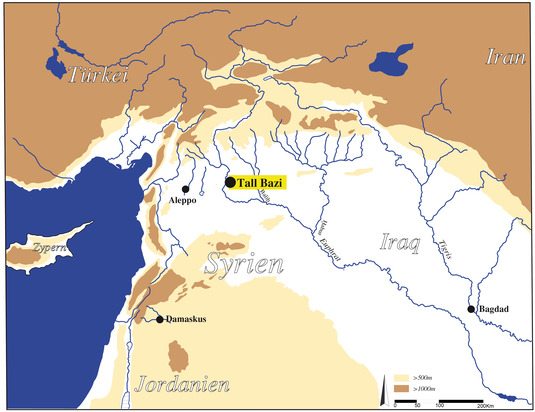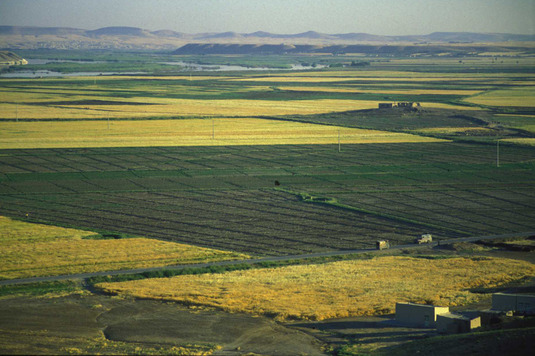Location and Description
Location
Tall Bazi is situated in today's northern Syria, approx. 60 km south of the Turkish border at the upper section of the Syrian Euphrates, where the Euphrates valley dilates into a fertile meadow of around 2.5 km width. There, at the eastern side of the valley - i.e. still in the Gazira or in Mesopotamia - a cluster of ancient settlements has been discovered, which prove a continual inhabitation in this region from the Obed period into the Late Roman epoch.
Ever since the Tishrin dam was closed in 1999, the Euphrates valley has been flooded by the Tishrin barrier lake. Up to then Tall Bazi used to be located approx. 1 km north of the villageof Abu Dame directly next the the village of Tall Banat. This village covered the vast Tall Banat, which was excavated by an American-Australian team under the direction of Ann Porter and Tom McClellan.
The ancient settlement of Tall Bazi was outlined at the fringe of the valley: the lower town a few metres elevated on a pebble terrace, the citadel on a natural rock spur or foothill of the Euphrates Mountain range, which rises around 60m above the valley meadow. Since the flooding of the meadow, the entire lower town and Tall Banat have disappeared. The citadel, by contrast, will never sink.


Map with the location of Bazi View from Bazi onto the fertile Euphrates valley before 1999
Rescue Excavations in the Euphrates Valley
Excavations in Bazi began as a part of the international rescue excavations, which had been conducted since the 1990ies in Northern Syria in the area of the Tishrin barrier lake. Over a length of 60 km, the new barrier lake covers the entire northern Syrian Eurphrates valley above the water reservoir near Tabqa up to the Turkish border. Numerous missions from varius nations feverishly worked on the exploration of the most important ruin sites, before they were flooded (see reports in: G. del Olmo Lete / J.-L. Montro Fenollós (Eds.), Archaeology of the Upper Syrian Euphrates: The Tishrin Dam Area, AuOr Suppl. 15, Barcelona 1999).
The Project
Das Project of Tall Bazi was initiated by Berthold Einwag, who was employed with the German Archaeological Institute (DAI) as Near Eastern Archaeology specialist representative. Since 1995, Berthold Einwag and Adelheid Otto have been sharing the project management.
Excavations started in spring 1993 as a part of the international rescue excavations in the Tishrin dam area. Initially, it was a research project of the formerstation of Damascus, later on renamed branch office Damascus of the Orient Department of the DAI, and was continued until 1998. From 2001-2010 the Deutsche Forschungsgemeinschaft (DFG) financed this project. It was anchored at the Institute of Near Eastern Archaeology of the LMU Munich (Head: Prof. Michael Roaf) from 2001-2008 and at the Johannes-Gutenberg-University Main from 2009-2012. Since 2013, it has been back at the LMU Munich.
Excavation campaigns were carried through from 1993-1997, in 1999, from 2001-2005 and again from 2007-2009. In the years of 1999, 2002 and 2010, reworking campaigns took place. Since this area had been unsafe from 2011 onwards and became a war zone in 2014, no more excavations have been conducted since. The rework, however, continues in Germany.

